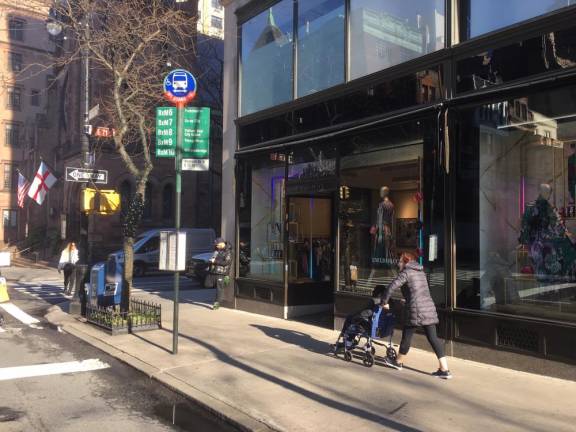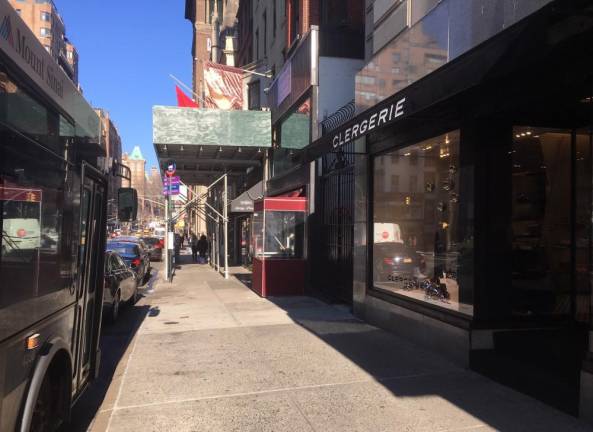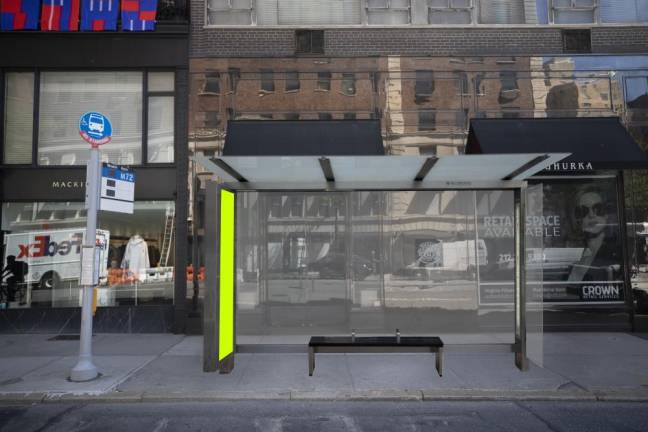The Barricading of Madison Avenue
Merchants denounce a city plan to install bus shelters on the super-luxe shopping strip, saying they’ll obstruct storefronts, drive away patrons and ruin businesses.
A new threat is facing the crown jewel of American retailing. But it’s not from Amazon. Nor the explosion of cyber-spending. And it can’t readily be blamed on the seismic shift away from a brick-and-mortar universe.
In fact, the culprit is much more local: If you listen to Madison Avenue merchants and Upper East Side community leaders, they’ll tell you it isn’t the global retail landscape at all. The villain, they argue, is City Hall.
The city’s Dept. of Transportation has been developing tentative plans to install nine covered, stainless steel-and-glass bus shelters on the east side of the iconic shopping stretch between East 57th and 78th Streets.
Exact design, dimensions and locations will be unveiled later this year, DOT says. The addition of shelters will provide benches, relief from the weather and way-finding for all riders, the agency says.
“We would add that our bus shelters are designed to fit in well with the New York City-built urban environment,” a DOT spokesperson added.
Shopkeepers vehemently disagree. They fear the proposal would mar the 21-block streetscape, eliminate its uniqueness and undermine the commerce and upscale vibes of Madison Avenue.
The corridor has the narrowest sidewalks of any avenue in Manhattan. Just 12 to 13 feet wide, their already limited space would be abridged further if large, intrusive, blocky shelters were shoehorned into the pavement, critics say.
DOT guidelines require a minimum of three feet between curb and shelter. Since the structure itself would be about three-feet wide, a bottleneck would be created, and a tiny clearance path of barely seven feet would be left to funnel pedestrians.
Sabotaging the City's Poshest Boutiques
Storefronts would be blocked, sightlines through plate-glass windows into a world of jewelry, Swiss watches and fine French fashion, would literally vanish. The characteristic rhythms of the avenue could be fatally compromised, proprietors fear.
That’s because a shelter – ranging in length from 10 feet to 14 feet, standing almost nine-feet tall – would effectively blot out from 50 to 70 percent of an average 20-foot-wide, ground-floor shop display.
“They pay so much in rent to be able to be on that street, to attract the shoppers that can afford their goods – and now, the bus shelters could block off those shoppers, distracting or diverting them from entering the stores,” said Alida Camp, chair of Community Board 8, which represents the area and is fighting the proposal.
The economics are fairly simple: Anything that deters customers is bad business.
“If you’re a pedestrian, it will really feel like you’re walking through a tunnel,” said Matt Bauer, president of the Madison Avenue Business Improvement District since 1999.
That won’t help the avenue’s vacancy rate, which is hovering above nine percent in the BID’s territory, between 57th and 86th Streets.
While the back glass of the shelters will be clear and transparent, it will still feel like a long wall barricading the storefronts, interrupting the street’s reflection and ambiance, Bauer added.
“Anything that blocks a storefront makes that storefront 10 times less attractive for a retailer,” he said.
The bus shelters would also “create unpleasant, potentially unsafe pedestrian pathways, clutter the public way, exacerbate congestion and undermine the pedestrian experience and character of the avenue,” said Rachel Levy, executive director of the FRIENDS of the Upper East Side Historic Districts.
Since the bus stops are all situated on the east side of Madison, a “non-historic asymmetry” would alter the historic streetscape, and the eastern side would retain less of its special character than the western side, Levy added.
Billboard Near Bally, Chanel and Baccarat
As one of the world’s leading shopping destinations, Madison Avenue has the distinction of falling within three separate landmarked districts, the Upper East Side, Carnegie Hill and Metropolitan Museum Historic Districts.
Those designations mean that any time a merchant wants to put up an awning, alter a sign or change a window display, a green light is needed from the city’s Landmarks Preservation Commission. It also bars stores from posting illuminated ads, digital signage, neon or pulsating ad platforms.
None of those restrictions apply to the city, and DOT is planning seven-foot-tall digital advertising screens on the shelters, facing both north and south. Theoretically, a competitor, say, of Jimmy Choo, La Perla, Brunello Cucinelli or Christian Louboutin could advertise its goods directly in front of or adjacent to a rival.
“Competitor advertising could take customers away from the shops – and place a bright, flashing, moving, eye-catching, attention-grabbing graphic billboard at eye level right in the middle of Madison Avenue!” Camp said.
That puts native stores at a huge competitive disadvantage: “Our retailers are demurely presenting their products to the public,” Bauer said. Overnight, they’d be overshadowed by illuminated signs that would damage the corridor’s physical appeal and sap attention from its storefronts.
“We have existential concerns for the historic character, physical character and human scale of the street,” he added.
“In support of Mayor Bill de Blasio’s Better Buses Action Plan, we plan to bring new bus shelters to busy stops citywide, including on Madison Avenue,” a DOT spokesperson said.
They’ll be “slightly narrower” than standard-size shelters, the agency said. Details will be unveiled in a presentation later this year.
CB 8, FRIENDS and the Madison Avenue BID are all requesting a public hearing on the proposal before the city’s landmarks agency, which determines the appropriateness of sidewalk usage. But DOT said only that it would “consult” with the LPC.
invreporter@strausnews.com
“We have existential concerns for the historic character, physical character and human scale of the street.” Matt Bauer, president of the Madison Avenue Business Improvement District


